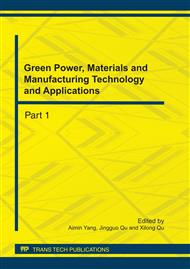[1]
Ming-Shun Lu, Chung-Liang Chang, Wei-Jen Lee, Li Wang. Combining the Wind Power Generation System With Energy Storage Equipment. IEEE Transactions on Industry Applications, 2009, 45(6): 2109-2115.
DOI: 10.1109/tia.2009.2031937
Google Scholar
[2]
Thresher, R, Robinson, M, Veers, P, To Capture the Wind. IEEE Power and Energy Magazine. 2007, 5(6): 34-46.
DOI: 10.1109/mpe.2007.906304
Google Scholar
[3]
Mary Black, Vera Silva. The Role of Storage in Integrating Wind Energy. International Conference on Future Power Systems, Amsterdam, Holand, 2005: 1-6.
Google Scholar
[4]
Erlich, I. Brakelmann, H. Integration of Wind Power into the German High Voltage Transmission Grid. IEEE Power Engineering Society General Meeting, Tampa, USA, 2007: 1-8.
DOI: 10.1109/pes.2007.385790
Google Scholar
[5]
Shuhui Li, Haskew, T. A, Energy capture, conversion, and control study of DFIG wind turbine under weibull wind distribution. IEEE Power and Energy General Meeting,. Calgary, Canada, 2009: 1-9.
DOI: 10.1109/pes.2009.5275870
Google Scholar
[6]
Xueqin Zheng, Donghui Guo. Study on the Connection of DFIG to Grid Based on Double-vector PWM. 2010 International Conference on Electrical and Control, Wuhan, China, 2010: 2139-2143.
DOI: 10.1109/icece.2010.526
Google Scholar
[7]
Lie Xu, Liangzhong Yao, Sasse, C. Grid Integration of Large DFIG-Based Wind Farms Using VSC Transmission. IEEE Transactions on Power Systems, 2007, 22(3): 976-984.
DOI: 10.1109/tpwrs.2007.901306
Google Scholar
[8]
Pannell, G, Atkinson, D.J., Zahawi, B. Analytical Study of Grid-Fault Response of Wind Turbine Doubly Fed Induction Generator. IEEE Transactions on Energy Conversion. 2010, 25(4): 1081-1091.
DOI: 10.1109/tec.2010.2049494
Google Scholar
[9]
Meegahapola, L.G., Flynn, D., Littler, T. Optimization of FRT active power performance of a DFIG during transient grid faults. 2009 International Conference on Industrial and Information Systems. Colombo Sri Lanka 2009: 477-482.
DOI: 10.1109/iciinfs.2009.5429813
Google Scholar
[10]
Jin Yang, Fletcher, J.E., O'Reilly, J. A Series-Dynamic-Resistor-Based Converter Protection Scheme for Doubly-Fed Induction Generator During Various Fault Conditions. IEEE Transactions on Energy Conversion, 2010, 25(2): 422-432.
DOI: 10.1109/tec.2009.2037970
Google Scholar
[11]
I. Erlich, H. Wrede and C. Feltes, Dynamic Behaviour of DFIG-Based Wind Turbines during Grid Faults. Power Conversion Conference, Nagoya, Japan, 2007: 1195-1200.
DOI: 10.1109/pccon.2007.373117
Google Scholar
[12]
Muller, S., Deicke, M., DE Doncker, R.W. Doubly fed induction generator systems for wind turbines. IEEE Transaction on Industry Applications, 2002, 8(3): 26-33.
DOI: 10.1109/2943.999610
Google Scholar
[13]
Hansen A. D., Gabriele Michalke. Fault ride-through capability of DFIG wind turbines. Renewable energy 2007, 32: 1594-1610.
DOI: 10.1016/j.renene.2006.10.008
Google Scholar
[14]
Johan Morren and Sjoerd W.H. de Haan. Short-Circuit Current of Wind Turbines With Doubly Fed Induction Generator. IEEE Transactions on Energy conversion, 2007, 22(1): 174-180.
DOI: 10.1109/tec.2006.889615
Google Scholar
[15]
Hansen A. D, Sorensen P, Florin I, Blaaberg F. Control of variable-speed wind turbines with doubly-fed induction generators. Wind Engineering 2004, 28: 411-432.
DOI: 10.1260/0309524042886441
Google Scholar
[16]
Olimpo Anaya-Lara, F. Micheal Hughes, Nicholas Jenkins, Goran Strbac. Rotor Flux Magnitude and Angle Control Strategy for Doubly Fed Induction Generators. Wind Energy 2006, 9: 479-495.
DOI: 10.1002/we.198
Google Scholar


